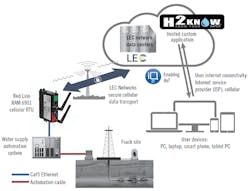Remember the lever, atlatl and sling? More recently, remember block-and-tackle, Vice-Grip locking pliers and the compound bow? Some are old and some are newer, but they're all ways of extending physical reach and delivering more concentrated power.
Wireless is a lot like all of these "force multipliers." It may not get all the recent attention lavished on the Industrial Internet of Things (IIoT), virtualization, cloud computing and others forms of digitalization, but none of these Johnny-come-lately phenomena would be as powerful without wireless technologies supporting them from behind the scenes. Oh, and wireless can bring in signals that can't be obtained with any other technology, or would be prohibitively costly to acquire even if other network methods could do it.
For instance, to remotely monitor and control water levels and prevent tank overflows during fracking operations, Magnus Services in Watford City, N.D., recently developed its H2Know solution, which is built on an iQ2 Industrial Internet of Things (IIoT) platform from LEC Inc. and IIoT-ready RAM 6900 cellular RTUs from Red Lions Controls. Where two to four people used to be needed per fracking site to monitor tank levels, turn pumps on and off, open and close valves, and call for more water trucks, H2Know provides near real-time data on water levels and control functions at fracking sites, and reduces the need for onsite support staff and visits.
H2Know also sends alerts on alarm conditions, and provides recording, reporting and trending, which lets Magnus' oil firm clients improve process control, take preventive steps to ensure proper water levels, and decide how to assign Magnus' mobile units more effectively. Magnus adds that its automated, wireless system can deliver data via cloud-based visualization and reporting, which can be accessed from web browser-based devices (Figure 1).
Figure 1: To monitor and control water supplies and tank levels at fracking sites, Magnus Services developed its H2Know solution, based on iQ2 IIoT platform from LEC and RAM 6900 cellular RTUs from Red Lion Controls. This wireless system can provide recording, reporting, trending, alerts and other data via cloud-based visualization, which can be accessed from any web-browser-based device. Source: Magnus, LEC, Red Lion
More invisible, keener presence
Some users, system integrators and suppliers observe that wireless is becoming so accepted that it's assumed it will be used and work effectively, which has rendered it transparent and taken for granted, even as it routinely serves in an increasing number of applications.
"Use of wireless in industrial applications is still growing, but it's also getting to be commonplace. We don't need to convince potential users about the technology anymore," says Garrett Schmidt, communication interfaces product manager, Phoenix Contact. "As a result, there's more network access everywhere and hardware and data costs are dropping, which means larger deployments. However, users still need to do site assessments for their applications, and most benefit from professional-grade components."
Schmidt reports that many wireless devices including Phoenix Contact's Radioline components continue to benefit by using 900 MHz for more transmit power over longer distances in North America. They've also been aided for many years by frequency-hopping for multi-path communications to avoid obstructions, which inherently makes eavesdropping more difficult. In addition, Radioline features 128-bit AES encryption, which has traditionally been part of wireless formats like WiFi (IEEE 802.11a-n). Phoenix Contact released its RAD-900-DAIO6 (Outdoor Radioline) 900-MHz, spread-spectrum transceiver earlier this year to make retrofit and expansion projects simpler and faster by eliminating or supplementing signal wiring for conventional I/O signals. It can monitor digital on/off status, actuate relay outputs, and transmit or receive 4-20 mA signals over up to 20 miles, while I/O signals can be mirrored at other stations in the wireless network or mapped to Modbus RTU for easy integration into a Modbus host system. One Radioline network can support up to 250 radios with any combination of repeaters and slaves, while its basic configuration requires no software.
In this month's podcast, Jim Montague speaks with Bob Karshnia, vice president and general manager of the wireless division at Emerson Automation Solutions, to gain greater insights into how industrial wireless is supporting the Industrial Internet of Things, digitalization and other new, emerging technologies. Tune in now.
"Users want to extend the reach of IIoT and the cloud, and dream of analyzing big data from numerous added sensors, but they're going to need wireless because you can't run wires everywhere," adds Schmidt.
Easier on the level
One of the primary applications where wireless has grown and been used the most in recent years is in level measurement and monitoring.
"Wireless is doing a lot of level measurement, though it's not replacing existing level transmitters, and is often used to deliver redundancy," says Bruce Billedeaux, senior consultant for wireless, energy optimization and cybersecurity at system integrator Maverick Technologies, a Rockwell Automation company. "We just finished a 63-tank field that gained redundancy by adding an all-wireless network and did an 80-tank field in Oklahoma that went completely wireless after having no automated tank gauging before.
"Wireless lets users to amplify the value of their wired networks to communicate more and achieve better utilization of their process applications. Plus, wireless provides an independent communication channel for devices like wired temperature sensors, which allow redundancy when a second, non-critical sensor is added, even though they're not using it for primary control."
Billedeaux adds that outside cable tray or underground cables can quickly double the cost of a project, but wireless will keep these expenses down because it can be half the cost of hardwiring. "Wireless components are also cheaper now. Wireless transmitters are about half the cost they were five years ago," he says. "In addition, they also work better now. Previously, we had to replace more radios, while suppliers would over-promise on performance. Now, wireless works more as advertised, which is crucial because process industry users expect 100% uptime. Dropouts once per day or even per week aren't acceptable, and we presently only see about one per month. If a wireless device is properly integrated into its application, you likely can't tell the difference between it and a wired device."
Bring in the field
Further proof of wireless' growing presence is that it's also spreading to more varied, smaller-ticket and more remote process applications. For instance, the Collaboratory for Strategic Partnerships and Applied Research at MessiahCollege and Open Door Development (ODD) recently partnered to deploy a tank-monitoring system in Mahadaga, Burkina Faso, a village of 5,000 residents bordering sub-Saharan, West Africa. In 2014-15, ODD established fresh-water distribution at several strategic points in Mahadaga, but it also needed to monitor the level in a remote storage tank located 100 feet up a cliff and over a ridge in rocky, tree-lined terrain. In the past, its water level had to be measured manually with a tape measure twice per day, but it was often found to be overflowing and wasting energy.
As a result, Tom Austin, project manager and senior Collaboratory associate, reports Phoenix Contact donated products and time to help his students design a wireless monitoring system for the tank, including Radioline wireless modules, power supplies, surge protectors, terminal blocks, antennas and cabling, though their main challenge remained establishing a link between the tanks on the ridge and the ODD office
“We did an initial test to see what we'd would get without a repeater, and were surprised when we had a connection and communication with our simple setup, though it was with poor signal strength that only lit the amber signal indicator," explains Austin. "Over the next few days, we kept testing and found better signal strength until we felt comfortable without using the repeater, which was good news because installing and protecting it would have been a significant undertaking. There were locations at each end that would've improved the line of sight, but even at non-optimized locations, we achieved three bars signal strength—one amber and two green—with the fourth bar occasionally coming on about half the time, which was more than enough for our needs. Plus, the radio equipment just worked, which made setup very simple, and allowed the final configuration to be the most useful."
Just like building a bridge or maintaining personal relationships, wireless communications need users to satisfy and maintain some essentials functions:
- Map and inventory all of a location or facility's physical characteristics, production applications, equipment and performance requirements.
- Document all application data types generated, including transmission packet sizes, speed and scheduling required for sending and receiving. Also, document them for all other local wireless traffic.
- Secure management approval, recruit internal wireless team members, and enlist external consulting/engineering services as needed.
- Detail existing and contemplated wireless formats and their performance characteristics, especially available distances and data-handling capabilities. Primary formats at present include: WiFi (IEEE 802.11a-n), ZigBee (based on IEEE 802.15, also foundation for WirelessHART and ISA100), Bluetooth (IEEE 802.15.1, no longer maintained), 6LoWPAN (IPv6 over low-power, wireless personal area network), traditional 2.4- and 5.6-GHz radios, and cellular communications based on 3G and 4G technologies.
- Evaluate data communication protocols and strategies at production and enterprise ends, such as Modbus and Modbus TCP, HART and WirelessHART, Profibus and Profinet, EtherNet/IP, Foundation fieldbus, Ethernet TCP/IP, or serial RS232 or RS485, and determine what they may need to work with a wireless format.
- Examine the site further for obstacles due to natural terrain, as well as barriers created by concrete and steel walls, support structures and frameworks, metal roofs and soffits, conveyors, remote motors and other rotating equipment. Also, account for routine movement by vehicles and other mobile equipment.
- Match available wireless formats with the site's individual coverage and data transmission requirements, and review cost-effective equipment and software options.
- Research antenna needs, options, placement and configurability. Different wireless formats may need different antennas. Remember "height is your friend," and don't put antennas under roof overhangs or motors. Many devices now have internal antennas, though these may not be sufficient. Many antennas can also be set up and aimed to further improve performance.
- Document power needs of wireless nodes, access points, wireless controllers and other transmission and receiving devices. Determine if line power must be provided, or if batteries can be used, which typically is based on the expected sampling frequency schedule and amounts of data communicated.
The complete wireless tank-monitoring system includes an ultrasonic distance sensor with an output serial string at 9,600 bps, radio transmit/receive system sending serial, and an Arduino module with touchscreen display. Together, they provide live level readings of the tank's water level; bar graph showing level over defined periods, typically 24 hours; and historical data storage onto an SD card at user-defined intervals, typically one minute. Overall, the tank monitoring system and the improved efficiency of the tank's two original pumps—now assisted by two solar-powered pumps—help keep up with demand during Africa's dry season.
"This system has been working really well, and has helped us reduce water waste," added Matt Walsh, director of ODD. "We haven’t had to run the generator at all to pump, and we’ve been able to turn the pump off more during the day and reduce its speed, too. During the rainy season, when demand is less, we've reduced over-pumping by 90% and decrease generator fuel consumption and pumping time and speed. The system has also allowed us to quickly identify leaks and to respond to short-term increases in demand. During the dry season, when the demand increases greatly, the monitoring is essential for assuring a constant water supply.”
Bluetooth benefits close-up
At less distance than the miles usually covered by cellular or hundreds of feet covered by WiFi, many users are taking advantage of wireless by working within the approximately 30 feet typically allowed by Bluetooth technology.
For instance, Östras Bröd in Halmstad, Sweden, recently implemented a rotary-style baking machine with slowly spinning cylinders that are easier to fill with flour and water, but it needed a way to communicate with its control cabinet 10 meters away. As a result, Austria-based machine builder Softec installed Anybus Wireless Bolt from HMS Industrial Networks, which is IP67-rated, has a maximum 100-meter range, and communicates using Bluetooth, Blue Low Energy, wireless local area network (WLAN), Ethernet, RS232/485 serial or CAN.
Softec put one Wireless Bolt on the machine and another on the cabinet to establish a narrow-band Bluetooth link, which is less affected by the stainless steel and other radio traffic in the bakery environment. Because the machine employs Siemens controllers, the link uses Profinet I/O protocol with a 64-millisecond I/O data cycle time.
“The alternative to using wireless on this machine would have been to use expensive sliprings,” says Andreas Kisch, general manager at Softtec. “However, everything that moves and turns wears down after awhile,
so we decided to go with a wireless solution that doesn't require any maintenance. The installation process was pretty much plug and play. We saved quite a bit of money by not having to use sliprings, and we didn't have to run a single cable.”
Likewise, recent renovations at drinking Water Treatment Plant No. 2 in Olathe, Kan., included installation of IQ3 electric valve actuators and Remote Hand Stations (RHS) from Rotork Controls Inc. At this gravity filter plant, 18 butterfly valves are located beneath a walkway, which made it hard to access and operate their former actuators. RHS eliminated this problem because its provides an exact duplicate of the actuator switches, display window and control interface, and is mounted on the walkway to enable users to conveniently and safely configure, operate and interrogate the IQ3 actuators below.
IQ3 and RHS have the same o-ring sealed, IP68, double-sealed enclosure, and share power and communication wiring at up to 100 meters. Also, RHS retains all of IQ3's functions presented in an identical window into the process, showing diagnostic data such as valve torque and usage profiles, while Rotork's handheld setting tool with secure Bluetooth wireless can gather all this data, and download it to a PC for analysis with Rotork Insight2 diagnostic software.
Sites, networks get help
Even though many aspects of implementing wireless are simpler and easier, pretty much everyone agrees that a thorough site survey remains critical for enabling wireless to handle the unique aspects of each location and application.
“Wireless does have the added complexity that users outside of your facility can affect your wireless system, and many users up until recently didn't fully understand those impacts. For instance, one client’s tank gauging system using 900-MHz wireless units was crashing everyday at 4 p.m., until they learned that all the nearby oil wells were reporting in at the same time with other 900-MHz devices using the same band,” explains Billedeaux. “This is one reason why site surveys are so important, but more users are aware now, and following this and other best practices, such as documenting how they’ve designed, set up and configured their wireless devices and networks.”
While there are still many individual devices that report back to single base radios, Billedeaux adds that equipment like a process skid can have 10-15 instruments trying to reach a PLC or DCS, so they're using improved wireless access points (AP) with more power and built-in processes such as active interference filtering. "Just like the WiFi router in a house, the base protocols of IEEE 802.11 haven't changed in 10 years, but the encoding and decoding protocols they've added have changed a lot," says Billedeaux. "This makes them much more reliable, and means an IEEE 802.11 router can do waveforming, which is using three antennas to direct signal strength in the direction they're aiming. This permits a higher density of field devices on the same network.
Shahram Mehraban, vice president of product development, Lantronix, reports that there are at least three recent advances in wireless standards and technologies that are coming to the industrial side:
- Dual-band WiFi allows a site to run at 2.4 GHz or 5 GHz, which means users no longer have to guess because connected devices will determine which one to use, and function right out of the box;
- IEEE 802.11ac is the latest addition to the WiFi standard, which increases its speed to 1.3 Gbps from IEEE 802.11n's 450 Mbps, allowing for more real-time data and determinism; and
- Long Range Wide Area Network (LoRAWAN) is a relatively new wireless standard that features a five-mile range and low power requirement, so more devices can use batteries and be cheaper to implement.
“In the past five years, there’s been a proliferation of wireless in public and outdoor areas. Users have become accustomed to high-speed connectivity, and are now requesting it in their facilities and process units. Centralized AP control developed for the consumer market, such as Cisco WAP controllers, enables seamless transfer of mobile users between APs, creating a user experience similar to what operators have in the control room with a high level of security. Recent advances also enable geolocation of mobile users within a few meters, providing the ability to geo-fence operations to operators located within specific units or areas.”
Coordinating collectives
Beyond making individual wireless connections simpler by unifying components and functions, recent innovations are allowing large groups of wireless devices to collaborate, surpassing even the switching and self-healing functions of mesh networks of a few years ago. Naturally, handling all this traffic quickly and successfully requires some serious monitoring and oversight.
For example, Central Hudson Gas & Electric Corp. serves about 300,000 electric customer and 79,000 natural gas customers in New York's mid-Hudson RiverValley, and it recently sought to establish a stronger, smarter and greener grid with increased automation and digitalization. The utility wanted to meet or exceed reliability targets and mitigate outages, but it also desired to improve voltage stability in the face of increasing distributed generation, electric vehicles (EV) and battery storage.
Central Hudson's project included implementing real-time wireless communications for its distribution management system (DMS) and 900 distributed automation (DA) devices, including electronic reclosers, switched capacitors, voltage regulators and sensors. Its new 2.4- and 5-GHz network would require 10 Mbps at gateways, 250 kbps at endpoints, less than 50 milliseconds latency, leased line replacement for smaller substations without fiber, centralized pressure monitoring at gas regulator stations, and consolidation of field area networks (FAN) to improve manageability and reduce costs. As a result, it deployed TropOS 1420 mesh edge nodes, TropOS 6420 mesh routers, SuprOS communication network management system and other products and services from ABB.
For twice the usual serving of educational resources related to wireless network design and deployment:
- Visit the latest resource guide
- Visit February's resource guide
The utility reports its wireless network provides real-time data to the DMS, allowing centralized decisions based on present system conditions. Also, extending the FAN to smaller substations without fiber provided a cost-effective replacement for leased lines, and allows communication with RTUs, access relays and other substation devices. These and other devices linked wirelessly can now send information automatically for analysis, enabling proactive maintenance and further reducing costs. Central Hudson adds its wireless network is facilitating monitoring and management of voltage levels for distribution and substation equipment, and enhancing power quality, system safety, and efficiency. As a result, the utility's gas operations will use the network to connect gas regulator stations to enable remote monitoring of pressure.
"Digitalization allows the collection of all kinds of new data, but it needs more pervasive communications to deliver those data to enable real-time analysis. Wireless is the enabling layer that's robust, secure, and reaches out to where all the devices are," says John Yelland, global marketing and international sales, ABB Wireless.








